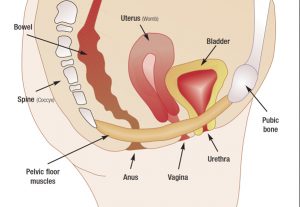Osteopathy & pelvic floor exercises for women

Introduction
The aim of today’s blog is to tell you how to exercise and strengthen your pelvic floor muscles. These muscles form a broad platform running from front to back, and as the name suggests, form the floor to the pelvis.
Functions of the pelvic floor
The functions of the pelvic floor are:
- To support the pelvic organs (i.e. the bladder, the rectum and, in women, the uterus).
- To control continence of urine and faeces from the bladder and bowel.
- To give tone and strength to the opening of the vagina.
It is important to maintain strength in these muscles in order to prevent problem occurring, or to increase their strength when problems do occur.
Problems
Problems can occur due to:
- Damage to the muscles as a result of pregnancy or during childbirth.
- Weakness of the muscles as a result of constipation, chronic coughing, being overweight, menopausal changes, persistent heavy lifting, long periods of inactivity due to injury or illness, abdominal or pelvic surgery and ageing.
- Being overweight will increase the amount of strain placed on the pelvic organs and muscles.
- Certain drinks (e.g. caffeinated drinks such as coffee, tea, colas, energy drinks, carbonated drinks) can irritate the bladder and subsequently increase a sense of urinary urgency.
- Straight leg sit-ups and double leg lifts put severe pressure on the pelvic floor.
- Picking up children / heavy weights.
Symptoms
We regularly see female patients who report one or a combination of the following symptoms:
- Stress incontinence (leakage of urine, faeces or wind) when coughing or with physical activity.
- Overactive bladder or urgency (urgent and/or frequent need to pass urine).
- Symptoms of a prolapse (e.g. sensation of a bulge or heaviness in the vagina).
- Decreased satisfaction during intercourse.
Basic exercises
Basic exercises can be carried out in any position (sitting, lying or standing) but it is important to be fully relaxed.
Method: Imagine that you are trying to stop yourself from passing wind and, at the same time, trying to stop your flow of urine mid-stream. The feeling is one of ‘squeeze and lift’, closing and drawing up the front and back passages.
Do this without pulling in your tummy, squeezing your legs together, tightening your bottom or holding your breath! In other words, only your pelvic floor muscles should be working. This is the ‘secret exercise’ (the exercise that nobody can see you performing): pelvic floor contraction.
Exercise programme
- Long, slow squeezes
Engage your pelvic floor muscles as described above. Hold tight for 5-seconds (at first) and build up to a maximum of 10-seconds.
Release the contraction fully and rest for 10-seconds.
Repeat this process as many times as you can (up to a maximum of 10 repetitions).
- How long can you hold the squeeze for?
- How many times can you repeat the contraction?
- Short, fast squeezes
This exercise builds up the strength of the pelvic floor muscles and helps them react quickly when you cough or sneeze.
Quickly engage your pelvic floor muscles as firmly as you can. Hold for only ONE second then let go fully for TWO seconds.
Repeat this as many times as you can (up to a maximum of 10 repetitions).
- How many quick squeezes can you do?
Frequency
The exercise programme should consist of a combination of:
- Endurance – slow and controlled exercises
- Speed – short, quick exercises
Ideally you should practice a set of long, slow squeezes followed by short, fast squeezes 5-6 times per day.
The most difficult part of the programme is remembering to do the exercises! Some useful methods of triggering your memory include: Squeezy NHS App on your Smart Phone; exercise after each time you empty your bladder; putting stickers in places that will catch your eye (e.g. on the bathroom mirror, on your Smart Phone screen, on the kettle, on the fridge).
Gradually the muscles will become stronger and you will be able to hold the squeezes longer and/or do more squeezes in a row.
The muscles will only get stronger if you build up the amount of exercises you can do. It may take several months before muscles regain their full strength.
How to check the effectiveness of the exercises
Once you have regained good control of your pelvic floor muscles, the muscles can be tested.
When your bladder is nearly full (up to 3 hours after last emptying it) stand with your feet apart and jump up and down on the spot / cough deeply twice.
Even if no leakage occurs, continue the above exercise programme for one more month.
Once your pelvic floor muscles are strong, it is important to maintain them.
Useful tips
- Remember liquid intake – do not restrict your intake, it will not reduce your symptoms. You are training your bladder to try and hold more urine (approximately 350ml).
- Frequency of bladder emptying – try to avoid emptying your bladder too frequently as this can reduce its capacity. If you feel like you need to do more often than once every 2 hours, then train your bladder to wait longer.
- If you get up in the night to empty your bladder, do not drink anything after 8.30pm.
- When you feel the urge to empty your bladder soon after having done so, try delaying tactics such as:
- Stand still or sit down
- Cross your legs
- Engage your pelvic floor muscles hard
- Wait until the urgency passes before carrying on with your activities
- Keep calm, avoid panic
- Distract yourself
- Delay going to the loo, gradually extending the time between emptying your bladder up to a maximum of 3 hours
Bladder emptying
It is important to completely empty the bladder every time, without straining.
Sudden movements
Try to tighten and hold the pelvic floor muscles prior to sneezing, coughing, etc. This will improve your control and reduce leakage of urine.
Advice
Please do not hesitate to contact us to discuss any aspect of this blog content – 01525 290615.
If your problems persist be prepared to seek further medical advice from a urologist, continence specialist physiotherapist or a gynaecologist.


